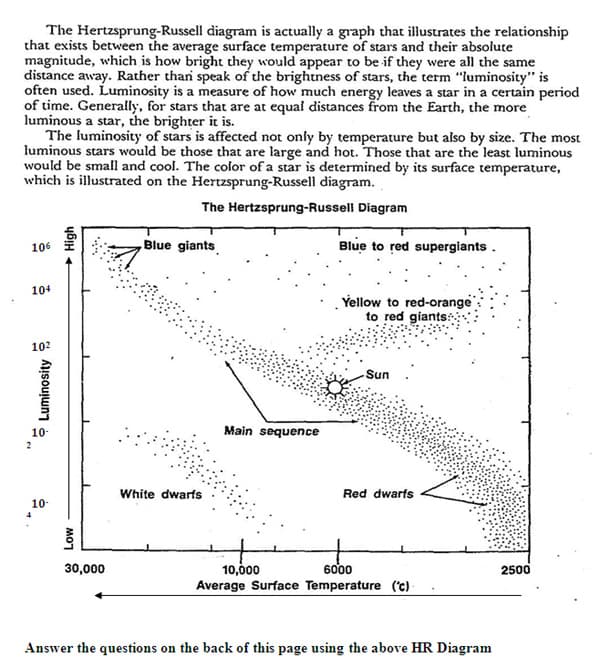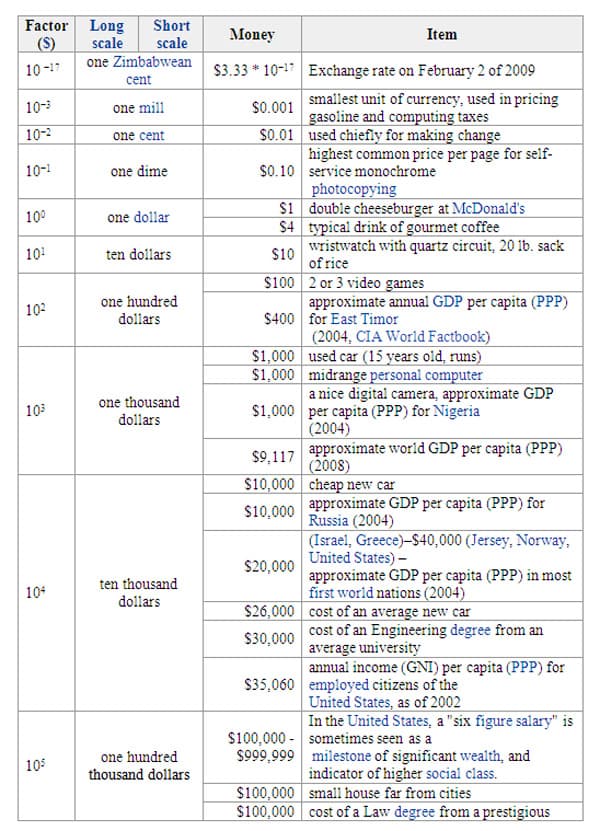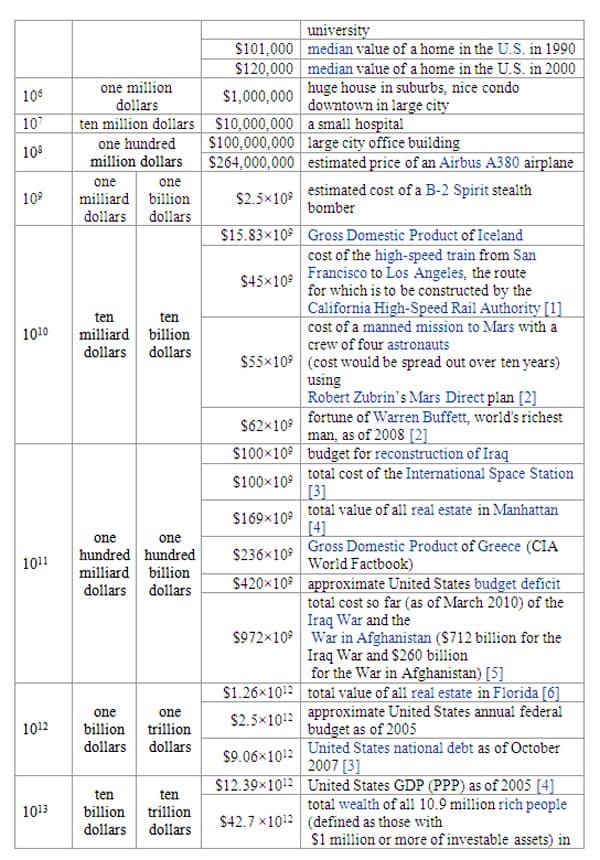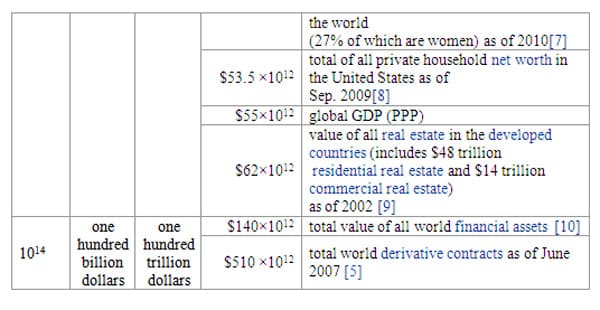Appendix
Problem sets for scientific notation
Order of magnitude/ expanded form
4) What place value is the 3 in the following number 12.35?
5) What is the highest order of magnitude for the number 12,357?
6) Express the following numbers in expanded form:
- 15, 237
- 170, 452
- 17.95
- .0347
- 1,453, 976, 421
7) Convert the following expanded form numbers to their normal decimal notation:
| a. | 5 x 10 3 + 2 x 10 2 + 4 x 10 1 + 6 x 10 0 |
| b. | 7 x 10 5 + 4 x 10 4 + 0 x 10 3 + 1 x 10 2 + 8 x 10 1 + 3 x 10 0 |
| c. | 8 x 10 2 + 7 x 10 1 + 3 x 10 0 + 9 x 10 - 1 + 4 x 10 - 2 |
| d. | 1 x 10 0 + 3 x 10 - 1 + 5 x 10 - 2 + 4 x 10 - 3 + 7 x 10 - 4 |
Money
What is the median household income of the US?
Identify the highest minority household income in the US? Compare the number in question 1 to question 2 and explain what that means
How many people have cell phones in the US?
How many families are on welfare? Compare this number to the number in question 4. Is there a connection? Explain why or why not
Identify the profits Comcast made last year.
Identify the profit (deficit) of the Philadelphia School District last year.
What is the ratio of question 6 to question 7? Explain what might be the cause of this terrific gap in profits.
What is the mean wage of a student that graduates high school? College? Graduate School?
Compare the ratios of mean wages for each level of school mentioned in question 9. Explain what the difference could mean.
Applications of Scientific Notation
Name
Scientific Notation is an important way to represent very big, and very small, numbers. Here is a sample of astronomical problems to test your skill using this number representation.
Problem 1: The Sun produces 3.9 x 10 3 3 ergs per second of radiant energy. How much energy does it produce in one year?(Hint: a year is about 3.1 x 10 7 seconds long.)
Problem 2: One gram of matter converted into energy produces 3.0 x 10 2 0 watts of energy. How many tons of matter in the Sun are annihilated every second to produce its luminosity of 3.9 x 10 3 3 ergs per second.
Problem 3: The mass of the sun is 1.98 x 10 3 3 grams. If a single proton has a mass of 1.6 x 10 - 2 4 grams, how many protons are in the Sun?
Problem 4: The approximate volume of the visible universe (a sphere with a radius of about 14 billion light years) is 1.1 x 10 3 1 light years. If a light year is 9.2 x 10 1 7 centimeters, how many cubic centimeters does the visible universe occupy?
Problem 5: The NASA data archive at Goddard Flight Center contains 25 terabytes of data from over 1000 science missions and investigations.(1 terabyte= 10 1 5 bytes) How many CD-roms does this equal if the capacity of a CD-rom is 6 x 10 8 bytes? How long would this take, in years, to transfer this data by a dial up modem operating at 56,000 bits/second? (Note: 1 byte = 8 bits)
Scientific Notation - Estimation
Money
Currently, the US is in the midst of the greatest recession since the 1920s. A recession is a general slow down in economic activity. In plain English, most people don't have as much money as they used to. This does not include companies like Apple, Pfizer, General Electric, and CBS who currently have a combined total value of 1.2 trillion dollars. That doesn't include their property value or income, just cash or cash equivalent they could spend tomorrow. Based on this information, estimate what these companies can buy if they released their money.
| a. | How many years could the companies pay the rent if the average for all US residents renting is $26.5 x 10 9/month? |
How many incomes could they provide if they the average household income was $50,221?
How many per capita (per person) incomes could they provide if the average per capita income was $27,041?
Compare a to b and b to c to find the ratios. What does the difference mean?
What is the relative error if you use $50,000 for the average household income, and 27,00 for the per capita?
| a. | If the average value of foreclosed homes in 2011 was $165,000 and there were 40,460 foreclosures in US during that year, how many of the foreclosures could the company buy? |
| a. | How many years could they pay gas bill if the average cost to fill up the tank each month was $250? |
9) What variables could causes the estimates to be inaccurate?
10) The average income per capita is $27,041. What percentage of a person's income is spent on gas per month, per year?
| a. | How much money could they give each US family, if there were approximately, 1.3 x 10 8 families in the US? |
| a) | Describe the best way a family could spend this money. |
| b) | How much richer would Philadelphians with the combined additional income provided by the companies? (Note: The population of Philadelphia is 1.5 x 10 6 people) |
Problem Suggestions
Population
1. What is the population of the world?
2. What is the population of the 10 largest countries (in terms of population)?
3. What percent of the world population is in the 10 most populous countries?
4. What is the ratio of the most populous country to the 10th most populous?
5. What percent of the world population is in China? In India?
Land Area
1. What is the total land area in the world?
2. What is the area of the 10 largest countries (in terms of area)? Also find: the area of the US not counting Alaska.
3.What is the percent of the total land area in the 10 largest (in terms of area) countries?
4. What is the ratio of the area of the largest country to the smallest?
5. What percent of the world's land area is in Russia? In Canada?
Population Density
1. What is the average population density of the world?
2. Suppose you don't count Antarctica as land area. What is the population density of the rest of the world?
3. What is the population density of China?
4. What is the population density of India?
5. What is the population density of the rest of the world, not counting India and China?
6. a) What is the population density of the US?
b) What is the area of Alaska? What is the population of Alaska? What is the population density of Alaska?
c) What is the area of the US not counting Alaska? What percentage is the area of Alaska, of the area of the rest of the US?
d) What is the population of the US not counting Alaska? What percentage is the population of Alaska, of the population of the rest of the US?
e) What is the population density of the US, not including Alaska?
f) What figure is most relevant to you, the answer to a), or the answer to e)?
g) What would it be like if the US had the same population density as India?
7. What is the population of Pennsylvania? What is the area of Pennsylvania? What is the population density of Pennsylvania?
Automobiles
1. How many automobiles are there in the US?
2. How many people per automobile are there? How many automobiles per person are there?
3. How many miles does an average car get driven in a year?
4. How many miles do all the cars in the US go in a year?
5. What fraction of a light year is the answer to 4? How long would it take us to drive the distance to the nearest star?
6. How many times the distance to Pluto is that?
7. How many gallons of gas do all the cars in the US use in a year?
8. How many pounds of CO2 do all the cars in the US produce in a year? (Figure 25 pounds per gallon.)
9. How many miles of roads are there in the US?
10. If all the cars in the US were evenly spread out on all the roads, how far apart would they be?
Solar system
1. What is the radius of Earth?
2. What are the radii of all the planets? (Debate whether to include Pluto.)
3. What is the ratio of the largest to the smallest? What is the ratio of Earth to the largest? To the smallest?
4. What are the distances of the planets to the Sun? (These are not constant. Take the average of the largest and the smallest.)
5. What is the radius of the Moon? What is the distance from the Moon to Earth? (Again, take an average.)
6. What is the radius of the Sun?
7. What are the volumes of all the planets and the Sun?
8. What is the ratio of the volume of the Sun to the volume of all the planets put together? Suppose that Earth were the size of a pea, and all other distances were in the same proportions as they actually are.
9. What would be the distance from the Moon to Earth?
10. What would be the radius of the Sun?
11. What would be the distance of Earth from the Sun? Would the Sun and Earth fit inside the classroom?
12. What would be the distance from the Sun to Jupiter? Would the Sun and Jupiter fit inside the school grounds?
13. Same question as 12, but for Neptune or Pluto.
14. What is the ratio of the radius of the Moon to the radius of the Sun? What is the ratio of the distance from Earth to the Moon, to the distance from Earth to the Sun? For this compute two different ratios first using the smallest distance from the Earth to the Moon, and then using the largest distance.
15. How do the ratios, of radii, and of distances, compare?
16. What does the answer to 15 have t o do with eclipses of the Sun? Does it have anything to do with eclipses of the Moon? What are the relevant ratios for eclipses of the Moon?
Cities
1. What are the 10 largest cities in the world, in terms of population?
2. What is the ratio of the largest to the smallest?
3. What percentage of the world's population lives in these 10 cities?
4. What are the 10 largest cities in the US, in terms of population?
5. What is the ratio of the largest to the smallest.
6. What percentage of the population of the US lives in these 10 cities?
7. Choose any country from the following list: England, France, Germany, China, Mexico, Australia, Canada, Brazil, Japan, India. Answer the same three questions for this country.
Money
1. What is the median wage in the US?
2. What is the median household income in the US?
3. What is the reason for the difference between 1 and 2?
4. How many households are there in the US? How many workers are there?
5. What is the ratio of the second number in 4 to the first? What does it mean?
6. If every worker made the median wage, how much money would that be?
7. If every household had the median income, how much money would that be?
8. What is the ratio of 6 to 7? Why might they be different?
9. Suppose that Philadelphia had households of average size, and they all made the median income. How much money would that be?
10. What is the total Gross National Product (GNP) of the US?
11. What is the ratio of 9 to 6? What could be reasons for the difference?
12. Who are the 10 richest people in the US and what are the net worths? What is the ratio of the smallest to the largest?
13. What is the total net worth of these 10 people?
14. What is the ratio 13 to 6?
15. What is the ratio 13 to 9? What does this mean?
16. What is the total value of real estate (all land and buildings) in Philadelphia?
17. What is the ratio of 16 to 13? Could the richest 10 people buy all of Philadelphia? How much could they buy, or how much would they have left over?
18. If your parents have a credit card, find out the annual percentage interest rate. If they don't, find the annual percentage rate on the credit card of someone you know. How much is that per month?
19. If your parents have a savings account, find out the annual interest rate. If they don't have a savings account, go to a bank and find out the interest rate on their standard savings accounts.
20. Which is larger, the annual interest on a savings account, or the monthly interest on a credit card?
The Hertzsprung-Russell Diagram Practice Worksheet
Name ____________________________________ Period _____ Date _____________

THE H-R DIAGRAM
1. What is the approximate surface temperature of the sun? ___________________
2. Would the surface temperature of white dwarf stars be higher or lower than red supergiants? (Circle one of the bold words)
3. What is the color of the stars with the highest surface temperature? ___________
What is the color of the stars with the lowest surface temperature? ____________
4. Compare the Luminosity of a red supergiant star to that of a white dwarf? Identify the magnitudes and explain what you can interpret from the difference between them.
__________________________________________________________________
5. The luminosity of each star is measured by using 10 as its base to compare to the Sun. Explain what it means when a star has a luminosity of 10 - 5.
__________________________________________________________________
6. How is it possible for white dwarf stars to have lower luminosity than the sun even though the sun is cooler than white dwarfs?
__________________________________________________________________
__________________________________________________________________
__________________________________________________________________
__________________________________________________________________
7. Plot the following stars.
Star A = 4,000 0C and low/medium brightness
Star B = 6,000 0C and high brightness
Star C = 20,000 0C and low/medium brightness
Star D = 6,000 0C and medium brightness
Identify the type/color for each star:

Orders of Magnitude
(money expressed in United States dollars)




Comments: